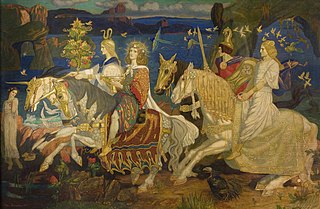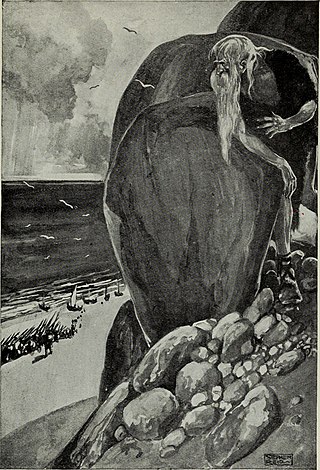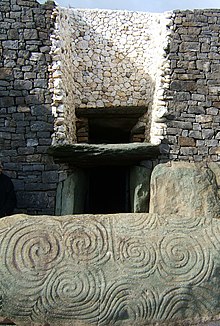
Irish mythology is the body of myths indigenous to the island of Ireland. It was originally passed down orally in the prehistoric era. In the early medieval era, some myths were transcribed by Christian monks, who heavily altered and Christianised the myths. Irish mythology is the best-preserved branch of Celtic mythology.

Lugh or Lug is a figure in Irish mythology. A member of the Tuatha Dé Danann, a group of supernatural beings, Lugh is portrayed as a warrior, a king, a master craftsman and a saviour. He is associated with skill and mastery in multiple disciplines, including the arts. Lugh also has associations with oaths, truth and the law, and therefore with rightful kingship. Lugh is linked with the harvest festival of Lughnasadh, which bears his name. His most common epithets are Lámfada and Samildánach. This has sometimes been anglicised as "Lewy of the Long Hand".

The Morrígan or Mórrígan, also known as Morrígu, is a figure from Irish mythology. The name is Mór-ríoghan in modern Irish before the spelling reform, and it has been translated as "great queen" or "phantom queen".

The TuathaDé Danann, also known by the earlier name Tuath Dé, are a supernatural race in Irish mythology. Many of them are thought to represent deities of pre-Christian Gaelic Ireland.

In Irish mythology, Aengus or Óengus is one of the Tuatha Dé Danann and probably originally a god associated with youth, love, summer and poetic inspiration. The son of The Dagda and Boann, Aengus is also known as Macan Óc, and corresponds to the Welsh mythical figure Mabon and the Celtic god Maponos. He plays a central role in five Irish myths.

Boann or Boand is the Irish goddess of the River Boyne (Bóinn), an important river in Ireland's historical province of Meath. According to the Lebor Gabála Érenn and Táin Bó Fraích she was the sister of Befind and daughter of Delbáeth, son of Elada, of the Tuatha Dé Danann. Her husband is variously Nechtan or Elcmar. With her lover the Dagda, she is the mother of Aengus.
In Irish mythology, Elcmar or Ecmar is the husband of Boann and belongs to the divine Tuatha Dé Danann. It has been suggested that he is Nuada under another name, and he is sometimes confused with Nechtan, Boann's usual husband. At first glance he appears to be associated with horses but there is also a school of thought that says his name means The Evil One. In the Dindsenchas, he is called "lord of horses" and is described as a judge. Elcmar is described as having a fork of white hazel, a gold brooch, and a cloak.

In Irish mythology, Nuada or Nuadu, known by the epithet Airgetlám, was the first king of the Tuatha Dé Danann. He is also called Nechtan, Nuadu Necht and Elcmar, and is the husband of Boann. He is mostly known from the tale in which he loses his arm or hand in battle, and thus his kingship, but regains it after being magically healed by Dian Cécht. Nuada is thought to have been a god and is related to the British and Gaulish god Nodens, who is associated with hunting and fishing. His Welsh equivalent is Nudd or Lludd Llaw Eraint.
In Irish mythology, Bres was a king of the Tuatha Dé Danann. He is often referred to by the name Eochaid / Eochu Bres. He was an unpopular king, and favoured his Fomorian kin.

Nemed or Nimeth is a character in medieval Irish legend. According to the Lebor Gabála Érenn, he was the leader of the third group of people to settle in Ireland: the Muintir Nemid, Clann Nemid or "Nemedians". They arrived thirty years after the Muintir Partholóin, their predecessors, had died out. Nemed eventually dies of plague and his people are oppressed by the Fomorians. They rise up against the Fomorians, attacking their tower out at sea, but most are killed and the survivors leave Ireland. Their descendants become the Fir Bolg.
In Irish mythology, Dian Cécht was the god of healing, the healer for the Tuatha Dé Danann, and son of the Dagda according to the Dindsenchas.
Ogma is a god from Irish and Scottish mythology. A member of the Tuatha Dé Danann, he is often considered a deity and may be related to the Gallic god Ogmios. According to the Ogam Tract, he is the inventor of Ogham, the script in which Irish Gaelic was first written.

Newgrange is a prehistoric monument in County Meath in Ireland, located on a rise overlooking the River Boyne, 8 kilometres (5.0 mi) west of the town of Drogheda. It is an exceptionally grand passage tomb built during the Neolithic Period, around 3200 BC, making it older than Stonehenge and the Egyptian pyramids. Newgrange is the main monument in the Brú na Bóinne complex, a World Heritage Site that also includes the passage tombs of Knowth and Dowth, as well as other henges, burial mounds and standing stones.
In the Mythological Cycle of early Irish literature, Midir, Midhir or Mider was a son of the Dagda of the Tuatha Dé Danann. After the Tuatha Dé were defeated by the Milesians, he lived in the sidh of Brí Léith. The name Midir may come from the old Irish word for a judge, midithir.

Cath Maige Tuired is the name of two saga texts of the Mythological Cycle of Irish mythology. It refers to two separate battles in Connacht: the first in the territory of Conmhaícne Cúile Tuireadh near Cong, County Mayo, the second near Lough Arrow in County Sligo. The two texts tell of battles fought by the Tuatha Dé Danann, the first against the Fir Bolg, and the second against the Fomorians.

The Mythological Cycle is a conventional grouping within Irish mythology. It consists of tales and poems about the god-like Tuatha Dé Danann, who are based on Ireland's pagan deities, and other mythical races such as the Fomorians and Fir Bolg. It is one of the four main story 'cycles' of early Irish myth and legend, along with the Ulster Cycle, the Fianna Cycle and the Cycles of the Kings. The name "Mythological Cycle" seems to have gained currency with Arbois de Jubainville c. 1881–1883. James MacKillop says the term is now "somewhat awkward", and John T. Koch notes it is "potentially misleading, in that the narratives in question represent only a small part of extant Irish mythology". He prefers T Ó Cathasaigh's name, Cycle of the Gods. Important works in the cycle are the Lebor Gabála Érenn, the Cath Maige Tuired, the Aided Chlainne Lir and Tochmarc Étaíne.
Delbáeth or Delbáed was one of several figures from Irish mythology who are often confused due to the repetition of the name in the mythological genealogies.
In Irish mythology, Cermait, also anglicized as or Kermit, of the Tuatha Dé Danann was a son of the Dagda and brother of Aed and Aengus. He was killed by Lugh after he had an affair with Lugh's wife Buach. The Dagda cried tears of blood for his son, and later, while traveling with his son's body in the east revived Cermait with a healing staff. Cermait's three sons, Mac Cuill, Mac Cecht and Mac Gréine, avenged his death, and went on to become joint High Kings of Ireland. Another figure mentioned in the Dindsenchas, Conan Honey-mouth, is described as the son of the Dagda and may be the same figure as Cermait. Conan was killed with a spear by a son of Conall Cernach named Ferdoman.
Aed, or Aodh, is the prince of the Daoine Sidhe and a god of the underworld in Irish mythology. He is known from inscriptions as the eldest son of Lir, High King of the Tuatha de Dannan, and Aoibh, a daughter of Bodb Dearg. Aed is elsewhere described in the Dindsenchas as being the Dagda's son and brother of Cermait and Aengus killed by Corchenn of Cruach for seducing Corchenn's wife.










